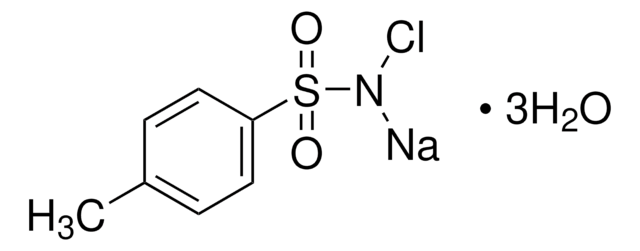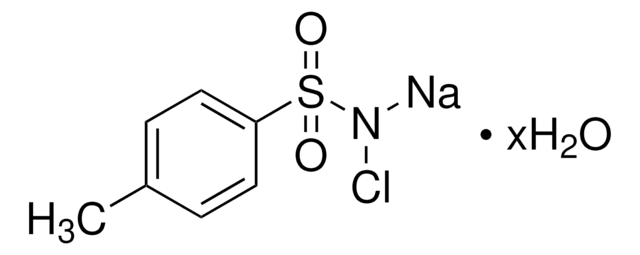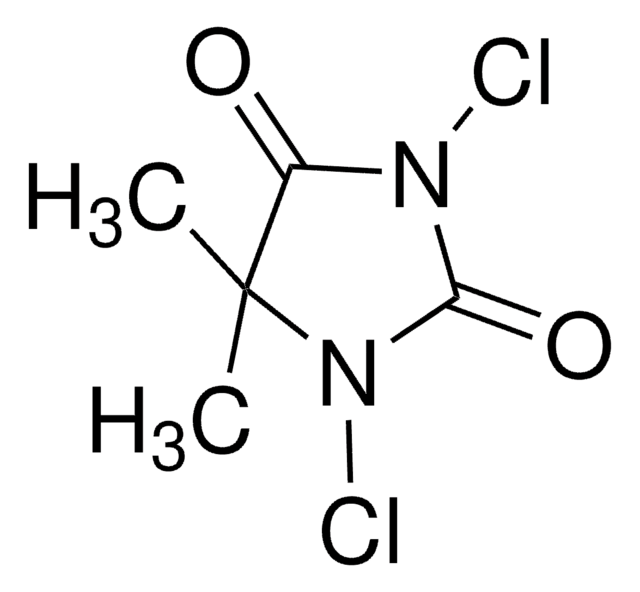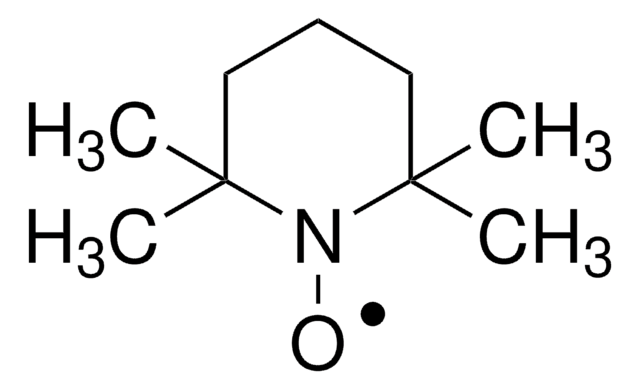23265
N-Chlorobenzenesulfonamide sodium salt
~28% active chlorine basis
Synonym(s):
Benzene chloramine, Chloramine B, Sodium (phenylsulfonyl)chloramide
Sign Into View Organizational & Contract Pricing
All Photos(1)
About This Item
Linear Formula:
C6H5SO2NClNa · aq
CAS Number:
Molecular Weight:
213.62 (anhydrous basis)
Beilstein:
3599287
EC Number:
MDL number:
UNSPSC Code:
12352002
PubChem Substance ID:
NACRES:
NA.22
Recommended Products
Quality Level
form
solid
reaction suitability
reagent type: oxidant
concentration
~28% (active chlorine)
SMILES string
O.[Na]N(Cl)S(=O)(=O)c1ccccc1
InChI
1S/C6H5ClNO2S.Na.H2O/c7-8-11(9,10)6-4-2-1-3-5-6;;/h1-5H;;1H2/q-1;+1;
InChI key
YVICIJMKLANTNN-UHFFFAOYSA-N
Related Categories
Application
Used in investigations of the toxicity response of electroactive microbial biofilms
Catalyst for rearrangement of aziridinofullerenes to azafulleroids
Oxidizing agent for polymerization of thiophenol, synthesis of o-aminobenzenesulfonic acids and ciproflaxin
Decontaminant for mustard
Catalyst for rearrangement of aziridinofullerenes to azafulleroids
Oxidizing agent for polymerization of thiophenol, synthesis of o-aminobenzenesulfonic acids and ciproflaxin
Decontaminant for mustard
Other Notes
Review
Signal Word
Danger
Hazard Statements
Precautionary Statements
Hazard Classifications
Acute Tox. 4 Oral - Resp. Sens. 1 - Skin Corr. 1B
Supplementary Hazards
Storage Class Code
8A - Combustible corrosive hazardous materials
WGK
WGK 3
Flash Point(F)
Not applicable
Flash Point(C)
Not applicable
Personal Protective Equipment
dust mask type N95 (US), Eyeshields, Gloves
Choose from one of the most recent versions:
Already Own This Product?
Find documentation for the products that you have recently purchased in the Document Library.
[Additional comments on the possibilities of using Chloramine B and Dikonit in a mixture with detergents].
J Kneiflová
Ceskoslovenska epidemiologie, mikrobiologie, imunologie, 35(1), 44-49 (1986-02-01)
[Microbicidal effects of Chlordetal--a new chlorine disinfective agent recommended for a single-stage method of disinfection].
V Melichercíková
Ceskoslovenska epidemiologie, mikrobiologie, imunologie, 37(1), 49-52 (1988-02-01)
N I Balakliets et al.
Mikrobiologicheskii zhurnal, 51(6), 83-86 (1989-11-01)
Strains of staphylococci, klebsiella, proteins, blue pus bacillus and enterobacteria resistant not only to antibiotics but also to chloramine, a disinfectant, were isolated from the test material samples obtained from patients with different purulent-inflammatory processes. The following strains are revealed
M G Shandala et al.
Zhurnal mikrobiologii, epidemiologii, i immunobiologii, (4)(4), 7-10 (2000-06-14)
The composition of ribosomal material in bacterial cells of 5 families, subjected to the minimal bactericidal action of iodine and chloramine-B, was studied with the use of electrophoresis in polyacrylamide gel. The study demonstrated that under these conditions protein-synthesizing organelles
M I Levi et al.
Zhurnal mikrobiologii, epidemiologii, i immunobiologii, (4)(4), 17-21 (1988-04-01)
The disinfecting effect of chloramine on P. aeruginosa depends on the concentration of this disinfecting agent, the concentration of P. aeruginosa and the period of exposure, with consideration for the time of attaining equilibrium between the concentration of chloramine and
Our team of scientists has experience in all areas of research including Life Science, Material Science, Chemical Synthesis, Chromatography, Analytical and many others.
Contact Technical Service









